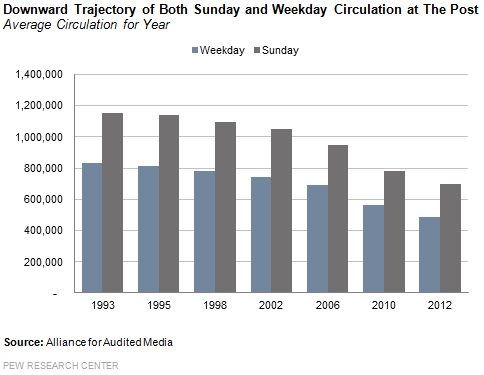On August 5, The Washington Post, which had been owned by the Graham family for 80 years, was sold to the billionaire founder of Amazon.com, Jeff Bezos for $250 million in cash. Along with The Post, Bezos also bought the free tabloid, The Express, the weekly Spanish-language newspaper El Tiempo Latino, The Gazette chain of community newspapers, Southern Maryland Newspapers and Fairfax County Times. The Post’s online properties—including Slate, Foreign Policy and TheRoot.com—were not sold.
In recent years, like many large U.S. metro dailies, The Post has been deeply affected by the economic ills besetting the newspaper industry. The numbers below help tell that story.
Finances
- The company reported losing $49 million for the first half of 2013 on its newspaper operations, generating $138.4 million in revenue in the second quarter of the year. Of that loss, about $40 million was a pension expense, so the company lost about $9 million on operations.
- The losses in the first half of 2013 come after the company reported a $53.7 million loss in 2012, a $21.2 million loss in 2011, a $9.8 million loss in 2010 and a $163.5 million loss in 2009. In addition, in the past six years, overall operating revenue at The Washington Post’s newspaper holdings fell by 44%.
- The Washington Post Company’s market value is $4.2 billion, which includes its education business, including Kaplan Inc., and its television holdings. Of the company’s overall revenue in 2012, 14% came from newspaper publishing. Over half, 55%, was from education (Kaplan), 20% was from cable television, 10% was from television broadcasting and the remaining 1% was from other businesses. After the Bezos deal, the Graham family retains ownership of the educational and television businesses.
Circulation
- The average weekday circulation for the 52 weeks ending September 30, 2012 was 484,385, a decrease of 8.4% from the same period the year before. A few years earlier, in 2010, the circulation was over the half million mark at 562,108. The paper’s circulation peaked in 1993 at 832,332.
- Sunday circulation, a more lucrative area where some newspapers have seen growth recently, has also been declining. In the same 52-week period ending in the fall of 2012, Sunday circulation was 696,589, a 5.7% drop from the year before. At The Post’s peak in 1993, Sunday circulation averaged over a million—1,152,272.
- TheWashington Post’s combined market reach—measured by the number of people who read a print edition at least one day a week plus the number accessing that newspaper’s website at least once a week—was 56% for the 26 weeks ending March 31, 2013. That represents a slight decrease—from 59%—for the same period the year before.
Note: These data were compiled from earnings reports from the Washington Post Co., Alliance for Audited Media reports, and various media accounts.



